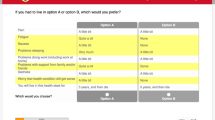Abstract
Objectives: It is postulated that patients with different cancer diagnoses, stages of disease and treatments will exhibit different individual preferences for health-related quality-of-life (HRQOL) functional domains and symptoms. Methods: A stated-preference (SP) instrument incorporating all functional domains and symptoms of the EORTC Quality of Life Questionnaire (QLQ-C30) was administered to 400 patients with either breast (n=150); colorectal (n=150) or non-small cell lung cancer (n=100) who had previously experienced chemotherapy. The SP survey asked patients to make choices between a series of hypothetical functional/symptom pairs defined by combinations of HRQOL attributes, and depicted by levels of functioning and symptomatology. Results: In the 400 patients, considered as one group, role, cognitive, and social functioning, fatigue, nausea/vomiting, pain, appetite loss, diarrhea and financial difficulties were most important, whereas physical and emotional functioning, dyspnea, constipation and insomnia were less important. The four effects that patients with breast cancer most wished to avoid were nausea and vomiting, pain, and decreases in emotional and role functioning. Patients with colorectal cancer listed diarrhea as the second most important effect to avoid (after nausea/vomiting, but before pain and role functioning), whereas those with non-small cell lung cancer listed dyspnea as the fourth most important effect to avoid. Conclusion: These results provide more precise information regarding patient treatment concerns than that provided by the usual measurement of HRQOL. This information can be used by clinical trial investigators to design more precise interventions to improve HRQOL in the domains of greatest importance to patients and by all health care professionals to improve counseling of patients.
Similar content being viewed by others
References
FR Johnson WH Desvousges (1997) ArticleTitleEstimating stated preferences with rated-pair data: Environmental, health, and employment effects of energy programs J Environ Econ Manag 34 79–99
M Ryan J Hughes (1997) ArticleTitleUsing conjoint analysis to value surgical versus medical management of miscarriage Health Econ 6 261–273 Occurrence Handle10.1002/(SICI)1099-1050(199705)6:3<261::AID-HEC262>3.0.CO;2-N Occurrence Handle1:STN:280:ByiA28bmvFA%3D Occurrence Handle9226144
FR Johnson WH Desvousges MC Ruby et al. (1998) ArticleTitleEliciting stated preferences: An application to willingness to pay for longevity Med Decision Making 18 IssueIDSuppl S57–S67 Occurrence Handle1:STN:280:DyaK1c3is1Wiug%3D%3D
M Ryan E McIntosh P Shackley (1998) ArticleTitleMethodological issues in the application of conjoint analysis in health care Health Eco Lett 2 15–21
FR Johnson MR Banzhaf WH Desvousges (2000) ArticleTitleWillingness to pay for improved respiratory and cardiovascular health: A multiple-format stated-preference approach Health Econ 9 295–317 Occurrence Handle10.1002/1099-1050(200006)9:4<295::AID-HEC520>3.0.CO;2-D Occurrence Handle1:STN:280:DC%2BD3cvgvFGntw%3D%3D Occurrence Handle10862074
Zwerina K, Huber J, Kuhfeld WK. A general method for constructing efficient choice designs. SAS Institute Market Research Document TS-689D, 1996; (http://support.sas. com/techsup/tnote/tnote_stat.html).
GW Torrance W Furlong DH Feeny MH Boyle (1995) ArticleTitleMultiattribute preference functions: Health Utilities Index Pharmacoeconomics 7 503–520 Occurrence Handle1:STN:280:BymD2cjptVw%3D Occurrence Handle10155336
DA Revicki NK Leddy C Brennan-Diemer et al. (1998) ArticleTitleDevelopment and preliminary validation of the multiattribute Rhinitis Symptom Utility Index Qual Life Res 7 693–702 Occurrence Handle1:STN:280:DyaK1M7pslKqsw%3D%3D Occurrence Handle10097618
DA Revicki NK Leddy F Brennan-Diemer et al. (1998) ArticleTitleIntegrating patient preferences into health outcomes assessment. The multiattribute Asthma Symptom Utility Index Chest 114 998–1007 Occurrence Handle1:STN:280:DyaK1M%2FgslSmtg%3D%3D Occurrence Handle9792568
F Wolfe SX Kong (1999) ArticleTitleRasch analysis of the Western Ontario MacMaster Questionnaire (WOMAC) in 2205 patients with osteoarthritis, rheumatoid arthritis, and fibromyalgia Ann Rheumatic Diseases 58 563–568 Occurrence Handle1:STN:280:DyaK1MzovFGntQ%3D%3D
F Wolfe K Michaud T Pincus (2004) ArticleTitleDevelopment and validation of the Health Assessment Questionnaire II – a revised version of the Health Assessment Questionnaire Arth Rheumat 50 3296–3305
AM Griffin PN Butow AS Coates et al. (1996) ArticleTitleOn the receiving end. V: Patient perceptions of the side effects of cancer chemotherapy in 1993 Ann Oncol 7 189–195 Occurrence Handle1:STN:280:BymB283jtVE%3D Occurrence Handle8777177
FR Johnson AB Hauber D Osoba et al. (2006) ArticleTitleAre chemotherapy patients’ HRQoL importance weights consistent with linear scoring rules? A Stated-Choice Approach Qual Life Res 15 285–298 Occurrence Handle10.1007/s11136-005-0581-4 Occurrence Handle16468083
N Aaronson S Ahmedzai B Bergman et al. (1993) ArticleTitleThe European Organization for Research and Treatment of Cancer QLQ-C30: a quality-of-life instrument for use in international trials in oncology J Natl Cancer Inst 85 365–376 Occurrence Handle1:STN:280:ByyC28vivVc%3D Occurrence Handle8433390
D McFadden (1981) Econometric models of probabilistic choice C Manski D McFadden (Eds) Structural Analysis of Discrete Data with Econometric Applications MIT Press Cambridge 198–272
Schoenberg R. Constrained Maximum Likelihood. Aptech Systems, Inc. 1996.
P Fayers S Weeden D Curran (1998) EORTC QLQ-C30 Reference Values EORTC Quality of Life Study Group Brussels
J Louviere (1988) Analyzing Decision Making: Metric Conjoint Analysis Newbury Park Sage
Author information
Authors and Affiliations
Corresponding author
Rights and permissions
About this article
Cite this article
Osoba, D., Hsu, MA., Copley-Merriman, C. et al. Stated Preferences of Patients with Cancer for Health-related Quality-of-life (HRQOL) Domains During Treatment. Qual Life Res 15, 273–283 (2006). https://doi.org/10.1007/s11136-005-0580-5
Accepted:
Issue Date:
DOI: https://doi.org/10.1007/s11136-005-0580-5



